When choosing glass bottles for your DIY perfumes, you'll want dark-colored options like amber or cobalt blue to protect against UV damage. Look for airtight seals and proper closures to prevent evaporation. Boston round bottles offer classic protection, while rectangular designs provide modern appeal. Keep your creations in cool, dark places at temperatures between 59-68°F. The right container choice can make the difference between a lasting signature scent and a spoiled experiment.
Understanding Glass Types for Perfume Storage

Three key factors make glass the premier choice for storing perfumes: its impermeability, non-reactive nature, and ability to protect against light damage.
When you're selecting glass containers for your DIY perfumes, you'll want to focus on these essential properties to maintain your fragrance's integrity.
For the best protection, you'll find dark-colored Boston round bottles particularly effective, as they offer superior light protection.
If you prefer a more modern aesthetic, rectangular glass bottles provide both style and practicality, making them easier to store and handle.
You'll notice that glass outperforms plastic and metal alternatives, as it won't contaminate your perfume or allow unwanted substances to seep through.
Plus, glass bottles are customizable, so you can choose designs that match your personal style while ensuring your fragrances stay fresh. Round bottles are especially popular since they offer timeless appeal and sophisticated elegance in perfume design.
Essential Features of Quality Perfume Bottles
Now that you understand glass types, let's focus on what makes a quality perfume bottle stand out. Your bottle should be airtight with a secure closure – look for screw necks or crimp necks that prevent evaporation and contamination.
The shape matters too; choose rounded or oval designs for feminine scents, or geometric styles for a modern appeal. The bottle design should incorporate proper ergonomic grip to prevent accidents during handling.
When selecting size, consider your fragrance's concentration. You'll want smaller bottles (30ml) for concentrated perfumes and larger ones (100ml+) for lighter formulations that need frequent reapplication.
The neck design isn't just about aesthetics – it affects functionality. Metal or plastic necks must be compatible with your fragrance composition.
UV Protection in Glass Container Selection
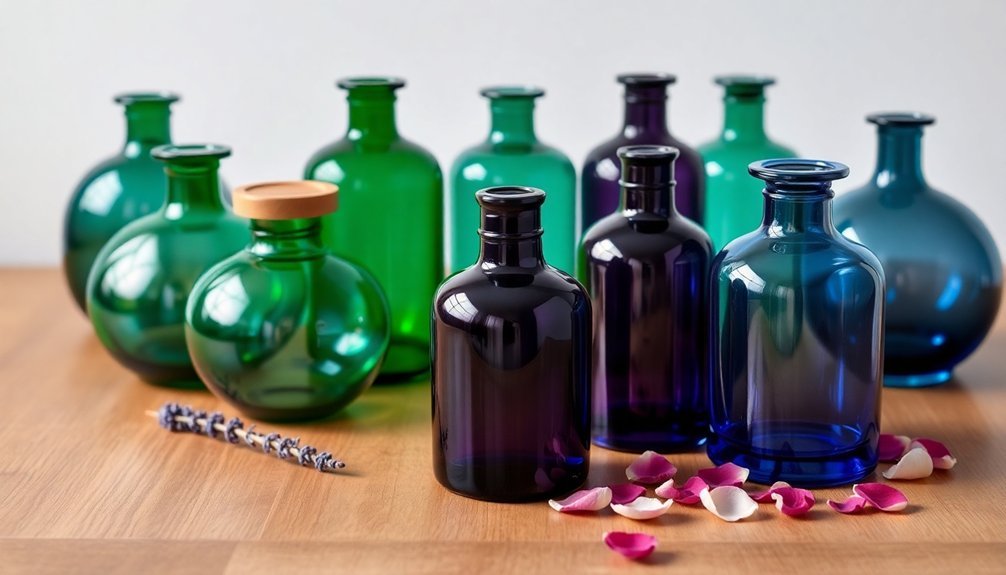
Protecting your perfume from harmful UV rays starts with selecting the right glass container.
You'll want to choose either dark-colored bottles, like amber or cobalt blue glass, or containers with integrated UV protection. These specially designed containers shield your fragrance from both UVA and UVB radiation, which can break down the molecular structure of your perfume.
For clear glass lovers, you've got options too. Leading manufacturers like Heinz Glas offer invisible shield technology that provides superior protection.
Look for bottles with invisible UV protective coatings or sprayed varnish that offer similar protection without compromising the aesthetic appeal.
When selecting your container, check if it's made with high-purity materials and meets quality control standards.
Proper Sealing Methods for Fragrance Preservation
When creating your own perfume, proper sealing methods make all the difference in preserving your fragrance's quality and longevity. You'll find several effective options, from small caps for splash bottles to parafilm for additional protection.
For the most secure seal, consider crimping technology, which creates a hermetic seal using a metal ferrule around the pump.
If you're working with screw-top bottles, you can enhance their seal using PTFE or plumber's tape around the threads before applying the cap.
Don't forget to combine these methods with proper storage practices. Always verify your containers are tightly sealed and stored in a cool, dark place with low humidity.
For rarely used fragrances, consider decanting them into smaller, airtight containers to minimize air exposure and extend their shelf life.
Material Safety and Chemical Compatibility
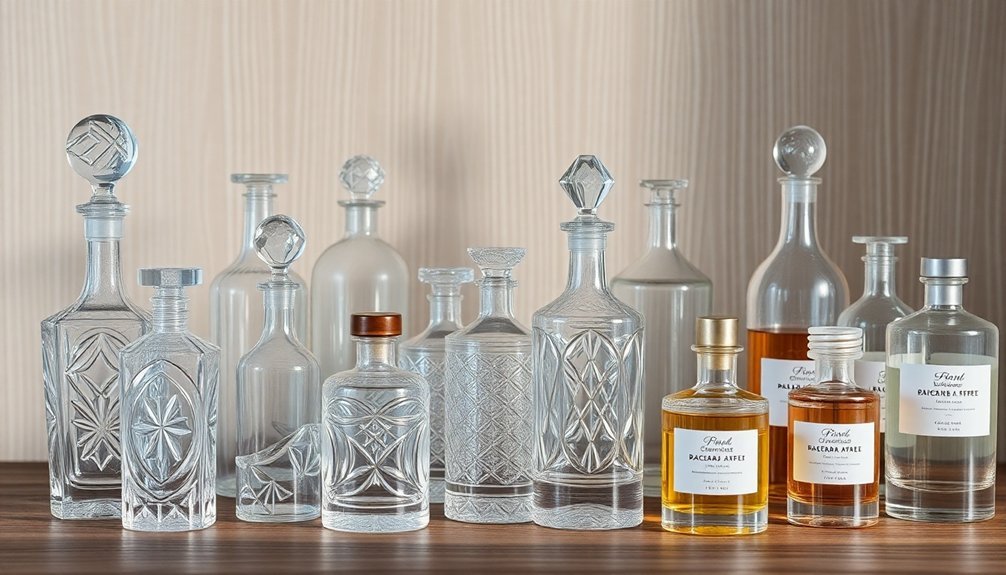
The selection of container materials directly impacts your fragrance's stability and shelf life. Glass, particularly borosilicate and Type I glass, offers superior chemical stability compared to plastic alternatives.
You'll want to avoid plastic containers since they can corrode and degrade when exposed to essential oils, alcohol, or UV radiation.
For ideal fragrance preservation, verify your container meets these vital requirements:
- Chemical inertness to prevent reactions with your perfume ingredients
- UV protection capabilities to shield against light degradation
- Impermeability to gases and moisture for maintaining scent integrity
- Compatible closure systems with appropriate gaskets (PTFE for alcohol-based formulas)
Always conduct stability tests to check for any pH changes or color variations in your DIY perfume.
Choosing the Right Bottle Size and Shape
Selecting an ideal bottle for your DIY perfume requires careful contemplation of both size and shape, as these elements dramatically impact your fragrance's presentation and practicality.
For size, you'll want to reflect on both your usage needs and storage requirements. Travel-sized bottles (30ml or less) offer great portability, while larger sizes (50-100ml) provide better value. Remember to leave room for expansion when filling your bottle, as alcohol can expand at higher temperatures.
When choosing shape, ponder both aesthetics and functionality. Rectangular bottles are space-efficient and easy to store, while round bottles offer a softer, more feminine appeal.
If you're aiming for a unique look, specialty shapes like hearts or geometric designs can make your perfume stand out. Just keep in mind that unusual shapes might be trickier to store and handle.
Cleaning and Sterilizing Glass Containers
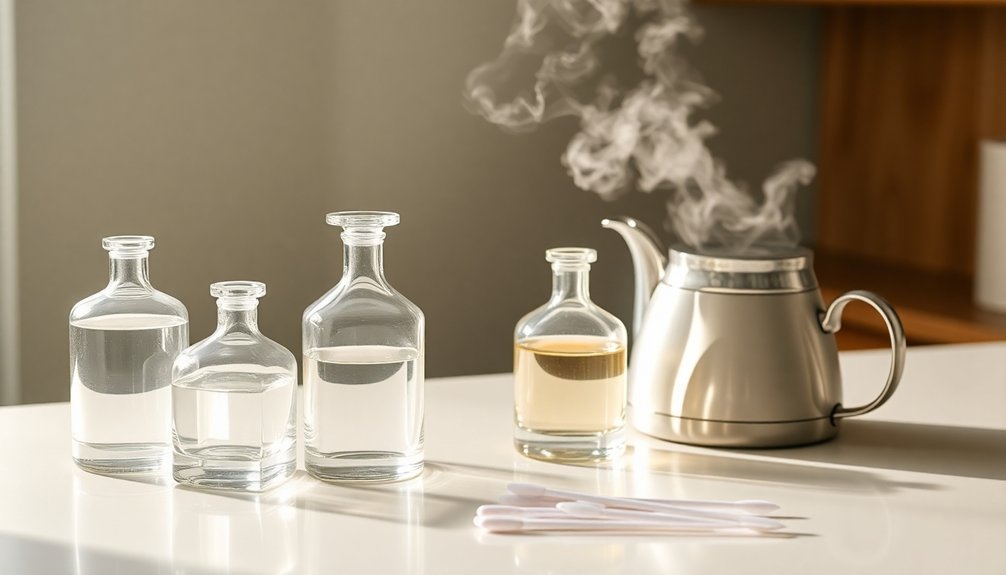
Before filling your perfume bottles, you'll need to sterilize them properly to guarantee your fragrance remains pure and uncontaminated.
You can choose from several effective methods, including boiling water, running a dishwasher sanitize cycle, or using alternative approaches like oven sterilization.
When sterilizing containers, always handle hot materials with proper tools and protective gear to prevent burns or accidents.
Sterilization Methods and Steps
Properly sterilizing your glass perfume containers guarantees both safety and scent integrity.
For borosilicate glass containers, you'll find steam sterilization most effective at 121°C for 20 minutes, keeping closures loose during the process. If you're using dry heat, maintain 160°C for 2-3 hours, ensuring proper ventilation to prevent glass flaking.
For those who can't use heat methods, consider these alternative approaches:
- Chemical sterilization using quaternary ammonium compounds or ethanol (remember to rinse thoroughly)
- Boiling method – submerge bottles in water for 10 minutes
- Dishwasher sterilization using the high-heat setting
- Microwave sterilization for small batches by partially filling with water
Always inspect your containers for damage before use, and maintain sterility until you're ready to fill them with your perfume formulation.
Safety During Container Cleaning
When cleaning perfume containers, safety must be your top priority to prevent accidents and exposure to harmful substances. Always work in a well-ventilated area and wear protective gloves to shield your skin from cleaning agents and residual perfume materials.
Handle fragile glass containers with extra care, and don't use sharp objects that could damage the atomizer or bottle. You'll want to avoid hot water burns by being cautious when cleaning with warm water. Instead of harsh chemicals, stick to mild soap or dishwashing detergent for effective cleaning.
When working with small components, place them on a clean towel to prevent loss and breakage.
Don't rush the cleaning process – take your time to properly disassemble, clean, and dry each part before reassembly to guarantee safe, long-lasting results.
Storage Tips for Bottled Perfumes
Store your bottled perfumes at room temperature in a cool, dark place away from windows and heat sources to maintain their quality and longevity.
You'll want to prevent direct light exposure by keeping bottles in their original boxes or opaque containers, as UV rays can break down the fragrance compounds.
When handling your perfumes, keep the bottles tightly sealed, avoid excessive shaking, and store them at a lower height to prevent accidental drops or breakage.
Ideal Temperature and Location
To maintain the quality and longevity of your bottled perfumes, keeping them at the right temperature and location is essential.
You'll want to store your fragrances at a consistent temperature between 15-20°C (59-68°F) to prevent degradation and chemical reactions that can alter their scents.
Choose storage spaces that maintain stable conditions, avoiding areas with temperature fluctuations like bathrooms and kitchens.
Instead, opt for these ideal storage locations:
- A bedroom dresser drawer or closed cabinet
- A closet with moderate humidity (around 50%)
- Original packaging with UV protection
- A dedicated small refrigerator for perfumes
Remember to keep your fragrances away from direct sunlight, heaters, and radiators.
Don't place bottles on high shelves to prevent accidental drops, and regularly check your storage conditions to guarantee ideal preservation.
Light Exposure Prevention
Protecting your perfumes from light exposure stands as one of the most essential steps in maintaining their quality and lifespan.
You'll want to store your fragrances in dark or lightproof containers, particularly amber or cobalt blue glass bottles that effectively block harmful UV rays.
Keep your perfumes in dark places like cupboards, drawers, or closets away from direct sunlight and artificial lighting. Your bedroom's wardrobe is an excellent choice, as it's typically less humid than a bathroom and offers consistent lighting conditions.
If you've purchased specialized perfume storage boxes, they'll provide additional protection against light and temperature changes.
Don't display your perfumes openly on vanities or dressers where sunlight can reach them. If you must showcase them, use light-filtering materials or keep them in their original packaging to preserve their chemical composition.
Proper Handling Techniques
Beyond protecting your perfumes from light, proper handling and storage techniques play an essential role in preserving your fragrances.
Always store your bottles upright to prevent leakage and minimize contact between the liquid and cap. When handling your perfumes, avoid excessive shaking as this can introduce unwanted oxidation and compromise the scent's integrity.
For ideal preservation, consider these essential handling practices:
- Store bottles in a temperature-controlled environment, away from humid areas like bathrooms
- Use high-quality protective materials like bubble wrap or foam inserts when moving bottles
- Keep perfumes in their original packaging or invest in a dedicated storage box
- Consider using a mini fridge or customized storage unit to maintain consistent temperatures
Remember to handle your bottles gently and avoid stacking heavy items on top of them to prevent accidental damage.
Decorative Elements and Personal Touches
Countless creative possibilities await when adding decorative elements and personal touches to your DIY perfume containers. You can transform plain bottles using spray paint or acrylics, then enhance them with miniature frames containing glycerin and glitter around the neck.
Add sparkle by applying bling around glass labels or caps, and customize the look with personal photos or changeable backgrounds. For a polished finish, create custom labels that match your chosen theme, or apply decorative stickers that complement the bottle's design.
You'll find that ribbons, bows, beads, and sequins can add extra flair. Don't forget to contemplate how you'll display your creations – strategic lighting can highlight your bottles' decorative elements, making them stunning accent pieces that match your home's decor or serve as thoughtful, personalized gifts.
Sustainable Options in Glass Container Selection
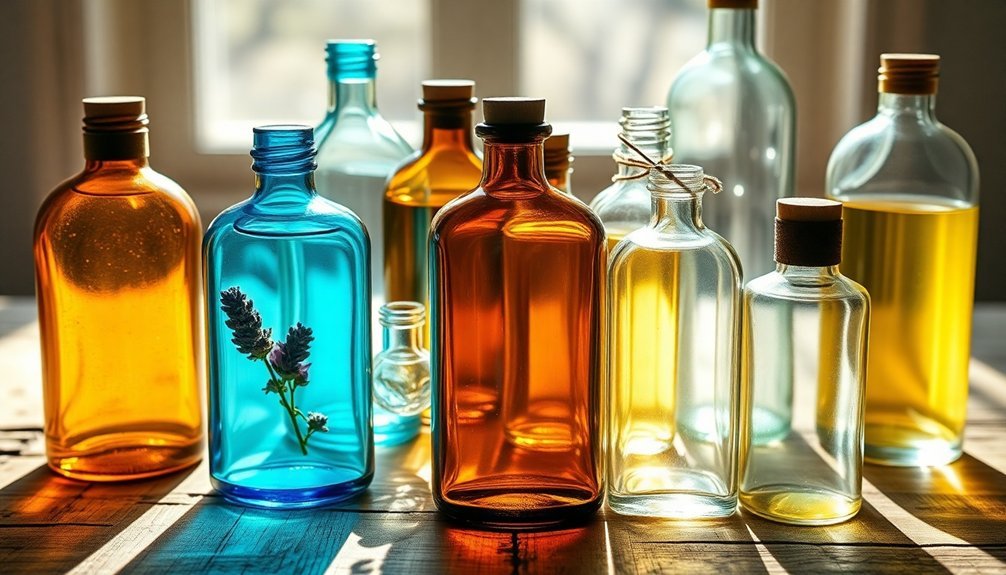
When choosing glass containers for your DIY perfumes, sustainable options offer both environmental benefits and practical advantages.
You'll find that PCR glass and refillable containers are excellent choices that reduce your environmental footprint while maintaining fragrance quality.
Consider these sustainable glass container options for your perfumes:
- Choose lightweight PCR glass bottles that can be easily separated from spray pumps for recycling
- Select refillable containers that you can use repeatedly, saving money and reducing waste
- Look for multi-purpose glass bottles that you can repurpose for other DIY projects
- Opt for durable, high-quality glass that preserves fragrance integrity without chemical reactions
You'll not only contribute to resource conservation but also enjoy the premium look and feel that glass containers provide, all while supporting environmentally conscious practices in your perfume-making journey.
Testing Your Bottles Before Final Use
You'll need to test your perfume bottles thoroughly by checking for leaks using water-filled containers left upside down for 24 hours.
Before adding your fragrance, verify bottle compatibility by testing a small amount of your perfume formula in a sample container for at least a week.
Check the bottle's durability by performing a gentle drop test from 6 inches onto a padded surface and examining for stress points using natural light at the recommended 40-50cm distance.
Leakage Test Methods
Before filling your DIY perfume bottles with precious fragrances, thorough leak testing is essential to prevent costly spills and wasted ingredients.
You'll want to conduct simple yet effective tests to verify your containers are perfectly sealed.
Here are practical methods you can use at home to test your perfume bottles:
- Fill the bottle with colored water and place it on white tissue paper – any leaks will show up clearly
- Apply gentle pressure to the filled bottle while holding it upside down to check for cap security
- Submerge the sealed bottle in water and look for any air bubbles, which indicate leaks
- Test the spray mechanism by pumping it several times with water to verify consistent performance
Remember to test bottles in various positions and under good lighting to spot potential issues before using your valuable fragrance ingredients.
Fragrance Compatibility Check
Testing your DIY perfume bottles for fragrance compatibility marks a critical final step before introducing your precious scents.
You'll need to carefully examine each bottle for cracks, breaks, or tiny air bubbles that could compromise your fragrance's integrity.
Start by checking the bottle's surface for any imperfections and ascertain uniform color throughout.
Verify that the glass material won't react with your fragrance components, as certain materials can trigger unwanted chemical reactions.
Pay close attention to the thickness of the bottle's walls and base – they should be consistent and sturdy enough to protect your creation.
Don't forget to test the cap's fit; it must seal properly to prevent leakage and contamination.
If you're using labels, make sure they're securely attached and won't interfere with the bottle's functionality.
Durability Assessment Steps
After confirming your bottles' compatibility with fragrances, a thorough durability assessment stands between you and your final perfume creation.
Before filling your bottles with precious fragrances, you'll want to verify they can withstand daily handling and potential accidents.
Here's what you should test for ideal bottle durability:
- Perform a basic drop test from waist height onto a padded surface to check impact resistance.
- Subject bottles to temperature changes by moving them between room temperature and refrigerated environments.
- Check for leaks by filling with water, sealing tightly, and holding upside down for 24 hours.
- Test spray mechanisms multiple times to verify consistent operation and no leakage around nozzles.
Remember to conduct these tests with a small sample of your bottles first to avoid potential waste of your entire container inventory.
Frequently Asked Questions
Can Vintage Perfume Bottles Be Safely Reused for New DIY Fragrances?
Yes, you can safely reuse vintage perfume bottles for DIY fragrances after thoroughly cleaning them. Just make sure you've removed all residue, disinfected the bottle, and checked that the stopper or cap seals properly.
How Long Can Perfume Remain Stable in a Properly Sealed Glass Bottle?
Your properly sealed perfume can remain stable for 3-5 years if you store it correctly. You'll get the best results by keeping it away from light, heat, and humidity in its original glass bottle.
What's the Best Method for Removing Stubborn Perfume Labels From Glass Bottles?
You'll get the best results by soaking bottles in warm, soapy water for 30 minutes, then using OxiClean solution. For stubborn residue, apply lemon essential oil and scrub with a non-abrasive cloth.
Are Colored Glass Bottles More Expensive Than Clear Ones for Perfume Storage?
Yes, you'll find colored glass bottles are more expensive than clear ones due to additional processing costs. However, they provide better UV protection for your perfumes, which can make them worth the extra investment.
How Can I Test if My Glass Bottle Has Proper UV Protection?
You can test your bottle's UV protection by placing two identical samples – one in your bottle and one in clear glass – in direct sunlight. Compare them after several days for color changes.
In Summary
When you're ready to bottle your DIY perfumes, you'll want to invest in quality glass containers that protect your creations. Choose amber or cobalt bottles with secure closures, test them thoroughly, and consider adding personal touches to make them uniquely yours. By following proper storage guidelines and selecting the right materials, you'll guarantee your handcrafted fragrances stay fresh and potent for months to come.

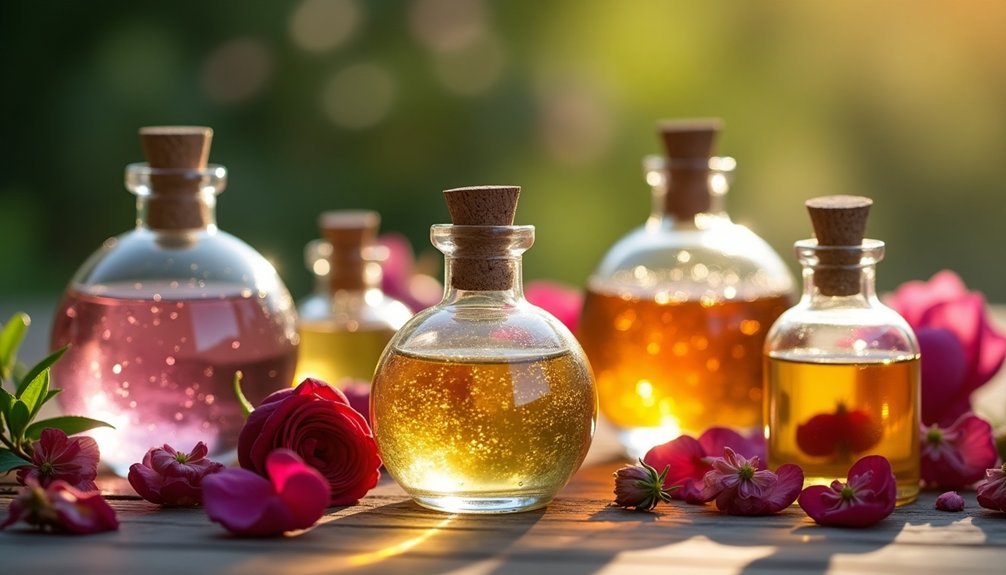



Leave a Reply